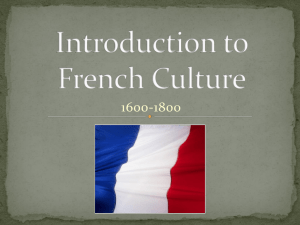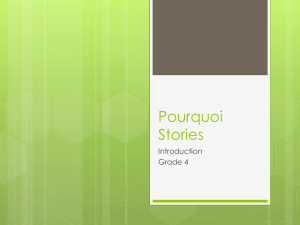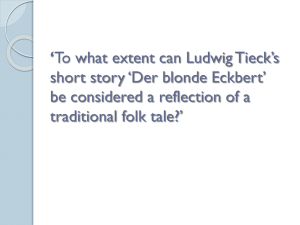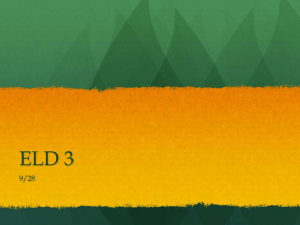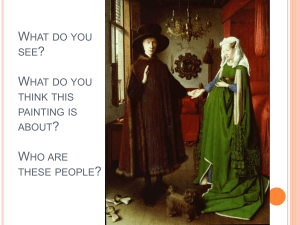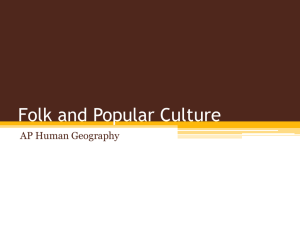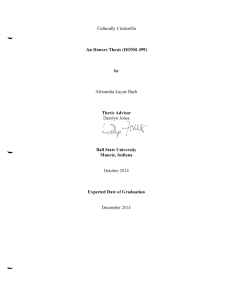Literature_in_the_classroom_2
advertisement
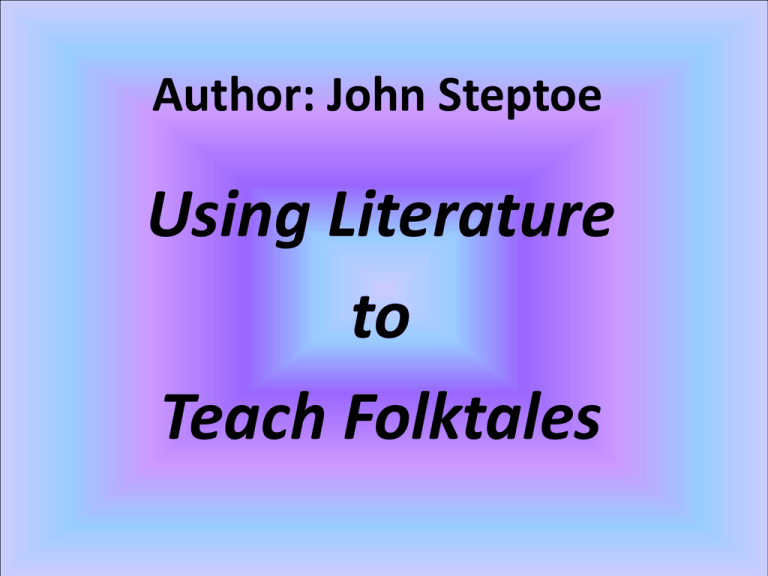
Author: John Steptoe Using Literature to Teach Folktales John Steptoe is an award winning author and illustrator for children’s books dealing with aspects of the African American experience. He is best known for Mufaro’s Beautiful Daughters, which was acknowledged by literary critics as a breakthrough in African history and culture. • Caldecott Honor Book • Reading Rainbow Book • ALA Notable Children’s Book • Coretta Scott King Award (Illustrator) • Boston Globe–Horn Book Award • Horn Book Fanfare Caldecott Honor Book Seal Born on 14 September 1950 and raised in the Bedford-Stuyvesant section of Brooklyn, New York, John Lewis Steptoe attended the New York School of Design and an afternoon art program sponsored by the Harlem Youth Opportunity Act from 1964 to 1967. In 1968, Steptoe was recruited as a senior in high school by John Torres to attend an eight-week summer program for minority artists at Vermont Academy. There Steptoe met Philip Dubois, who provided him with a place to work at the end of the summer session. While he was a student at Vermont Academy, Steptoe wrote and illustrated his first novel, Stevie. Published by Harper in 1969 and reprinted in Life, Stevie vaulted the nineteen-year-old Steptoe into the limelight. Written by an inner-city African American teenager and directed at inner-city African American youth, Stevie was lauded by the critics for its appeal to white as well as black audiences. Steptoe's use of inner-city dialect and his depiction of an urban setting targeted an audience previously ignored by children's book publishers: urban African American youth. What made Stevie so popular, however, was Steptoe's choice of subject matter. His tale of jealousy and reconciliation addressed a universal theme to which readers of all colors could relate. Critique of Mufaro’s Beautiful Daughters John Steptoe is best known for Mufaro’s Beautiful Daughters, which was acknowledged by literary critics as a breakthrough in African history and culture. Based on an African tale from the 19th century, it required Steptoe to research his heritage giving him the chance to awaken his pride in his African ancestry. (From Wikipedia, the free encyclopedia) Most people who see the book have an immediate response: they both ooh and ahh. The illustrations are simply stunning. After that come expressions of astonishment: the listener or reader did not know that a range of Cinderella variants exists. Then people marvel at the nontraditional portrayal of an African country. (From“The Hunt for Multiethnic Literature” by Violet Harris, published in Publishing Research Quarterly) Other books by John Steptoe Genre: Folktale Introduce Folktales: Folktales began as oral stories that were told to help people explain the world around them. Some are fantastic with ogres and sprites, while others are more realistic. Folktales are found in just about all cultures. Long ago before books were available, people told stories as a way of preserving them. Today, many folktales have been retold and attractively illustrated as children's books. Mufaro's Beautiful Daughters was inspired by an African folktale. Building Background Knowledge •The illustrations in Mufaro’s Beautiful Daughters were inspired by the remains and the flowers of an ancient city in Zimbabwe. Zimbabwe is in South Africa. •Show the students where Zimbabwe is on a map of Africa. •The names of the characters in this folktale are from the Shona language and mean the following: Mufaro (moo-FAR-on) means "happy man" Nyasha (ne-AH-sha) means "mercy," Manyara (mahn-YAR-ah) means "ashamed," and Myoka (nee-YO-kah) means "snake". Activity/Reading Focus •On the chalkboard create a chart such as the one shown here. •Explain that the chart shows some of the main characteristics of a folktale. •Ask students to look for these as we read Mufaro's Beautiful Daughters. •Use their responses to complete the chart. Folktale Characteristics Good verses Evil There are magic or make-believe parts There is a lesson or moral The story takes place in a long-ago setting Good Verses Evil Character Analysis As a class, do character analysis of Manyara and Nyasha by making “character wheels.” •On the board or on a large piece of chart paper, write Manyara’s name in the center of a circle. •On spokes radiating from this circle ,write words that describe her. •At the end of each spoke, draw another circle. •In that circle, write an event from the story that provides evidence of the descriptive word written on its spoke. •Make the same kind of wheel for Nyasha. •Compare and contrast the descriptive words for both characters. Mufaro’s Beautiful Daughters is a “Cinderella” story. There are hundreds of versions of Cinderella from different cultures. Obtain several Cinderella stories and read them to the students. Examples: The Persian Cinderella by Shirley Climo; The RoughFace Girl by Rafe Martin. •Brainstorm a comparison chart with the students. •List the different versions of Cinderella down the left side of the chart. •Across the top, list items of comparison, such as the story setting, what the Cinderella character is called, who or what the “fairy godmother” is, under what circumstance Cinderella meets the prince, the magical elements in the story, the outcome,etc. •Discuss the similarities and differences of the versions after the chart is completed. Comparing Two Cinderella Stories Venn Diagram Notes Name________________________________ Date___________________ In Mufaro's Beautiful Daughter: Sister__________________________________________________________________ Friends or person who helps _______________________________________________ ___________________________________________________________________________________ Magic Person ___________________________________________________________ ___________________________________________________________________________________ How the king/prince finds out who Cinderella is _______________________________ ___________________________________________________________________________________ ___________________________________________________________________________________ In the Cinderella Story: Sisters_________________________________________________________ Friends or person who helps _______________________________________________ ___________________________________________________________________________________ Magic Person _________________________________________________________ ___________________________________________________________________________________ How the king/prince finds out who Cinderella is ________________________________ ___________________________________________________________________________________ ___________________________________________________________________________________ Extension on Folk Tales •Set up a classroom display "Our Favorite Folk Tales" and encourage students to bring in folk tale books from home to share. •Put up a world map and label the countries where folk tales you have read originated. •Every time you read a folk tale, have a group of students work on making a colorful banner of a character from the story. Write the character's name on the banner, draw a picture, and write descriptive words on sentence strips to be glued onto the banner. Example: Goldilocks (hungry, curious, tired, rude, blond hair) •Make folk tale kits. Gather items that relate to stories and place them in bags. After reading a story, use a kit to motivate students to talk about the tale. Let a student choose something from the bag. Then have the student explain how the item relates to the story. Extension on Folk Tales Continued •Rewrite a folk tale into a class big book. •It would be great if your school could get a storyteller to come in, or invite guest readers in to read folk tales to the students. (principal, librarian, parents, other teachers, other school staff) •Have a folk tale feast. Three Bears Pudding (instead of porridge), Castle Cupcakes, Red Riding Hood's Basket of Sandwiches. •At the end, make a graph of which folk tale was the favorite among the students.


